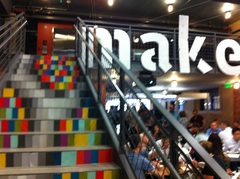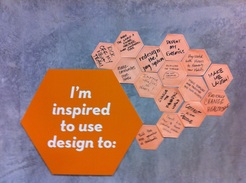|
I was so excited the day that Kill Decision by Daniel Suarez came out that I immediately dropped what I was reading and picked up a copy. I absolutely loved his first and second books. His writing is realistic (for techies), interesting, and explores very timely topics.
This latest book focused on autonomous military drones -- self-piloting and self-organizing planes used for reconnaissance and warfare. The title refers to the ability of certain drones (present or future) to make the decision to kill (as opposed to just gather data/imagery). The text explored lots of cool topics like computer vision (at Stanford!), laser-guided weapons, airplanes, helicopters, and swarm intelligence. I enjoyed the discussion of weaver ant research as well as the historical role of ravens living in symbiosis with humans. It also discussed modern social media manipulation for political (i.e., corporate) purposes. Drones are already a reality (the book specifically had scenes of military workers sitting in the US playing a "video game" (à la Ender's Game) but controlling real robots/planes halfway around the world. What happens when they will be self-organizing with kill decision authority? The book takes the view that this is a question of "when" and not "if," especially with parts and programming becoming off-the-shelf and lower cost. Will our laws and societal structures keep up/be ahead of this or behind? The book's heroes fight to stop a world with a "new age of warfare" with fully autonomous, kill-decision enabled drones built by "evil" people that eventually could destroy the world itself. Really fun read!
2 Comments
The last day of this design thinking extravaganza was all about storytelling and bringing these skills back to our organizations and communities. It was fun, and it was sad to end the process.
The whole thing ended with a major surprise. We were told at the end that 300 undergrads had signed up for a crash course on design thinking and had just arrived at the building. Guess who would be teaching them? Yep, it was us (newly minted design thinkers). At first, I was scared and worried that I wasn't ready to do this or provide a good experience for the undergrads. But in the spirit of "Don't get ready, get started," I just jumped into it and had a blast. The d.school has awesome facilitation guides and materials, and my teaching partner and I just went into it and did our best. The time constraints forced us to just get moving without worrying or thinking, and this worked to our advantage. I found that I learned a lot more about design thinking through teaching it and showing the concepts to others. Now I'm inspired to do this again for other groups (and learning more myself from the process and from others). Below are the rest of my notes and takeaways. Storytelling i. User -> character [use details to show this] ii. (user)Need + insight -> (character)tension, details of props, words iii. (user)solution -> (character)change iv. Use skits for storytelling (show > tell) 1. Record video, put into PPT v. Lo-tech better vi. Keep each step of process alive 1. Human centered, not tech centered Group 360 feedback i. I like, I wish for each name (names down the left, IL/IW on top as columns) ii. Each person puts post-its for all including self iii. 360 degree feedback for each team member dd. Another group feedback format i. Names down side, top: start, stop, continue (behaviors) Reasons and Intentions ii. “All reasons are bullshit” 1. Bottom line, effect matters 2. All behaviors/reasons are just justifications for self-image 3. You can always choose a different reason 4. “That’s a good reason” (sarcastic) 5. Don’t say to someone else their reasons are bullshit a. Just say to self 6. Change self, not world 7. Example: traffic as reason for being late a. Just give self more time 8. Reasons just convenient excuses 9. Reasons just excuse for own stuff iii. Intention 1. Need it to do something 2. Don’t try, just do 3. Hokkaido exercise of intention of moving vs. not moving arm 4. Design doing, not thinking 5. Doing easier than trying Bringing back to organization i. Self -> team -> org ii. Ax4: activities, artifacts, actors, atmosphere iii. Activities: bucket time in a meeting for ideation, selection, empathy iv. Actors: people at meeting, sometimes shake it up v. Atmosphere: change room vi. Artifacts: post-its, sharpies, bring list of related products, camera, do creative exercise at beginning vii. Steps 1. Identify goal 2. Discuss specific meeting 3. Discuss how usually done 4. Discuss how to do differently viii. Bring in consumers to meeting ix. Bring in crazy designers to shake it up x. Don’t expect the first step to bring result – just to start momentum xi. First thing: gift giving xii. Empathy = understanding, not sympathy DT for sales cycle 1. Metrics drive vs. human customers 2. The person who shows up w/ the prototype wins 3. Change a meeting with toys 4. Plus activity, warm-up to take into different space a. Stoking Teaching DT to undergrads i. Facilitator guide ii. 1 hour exercise iii. Prototyping materials iv. Just do, time constraint, partner v. Don’t give enough time to think, just do vi. 3 Learning modes 1. Some things you only learn by doing; some by teaching; some by traditional learning vii. Leaders manage time and prescribe time constraints viii. Keep shortening the time allowed ix. Time box (agile) x. Keep yourself on edge xi. Adapt, cultural translation of script, make it your own i. Book Make Space explains cheap DIY office design ii. Steelcase brand Final thoughts a. How to apply DT to my relationships? b. How to apply DT to my own self-development? Day 2 of the bootcamp was all about ideation and testing. We brainstormed a ton of ideas, voted, went through an excruciatingly painful but educational process of narrowing and deciding, and then whirred through several prototypes, killed half our designs and coming to something simple and focused by the end. It was an awesome day working with our hands, moving our feet, and testing physical, tangible versions of our ideas (which were service-oriented) on real people. Whoa.
The day concluded with an awesome panel talking about bringing design thinking back to their organization (large and small). Below are some of my most memorable takeaways from the day's activities and the panel. Ideation i. HMW questions: how might we 1. Break up POVs into mini-brainstorms w/ HMWs ii. IDEO brainstorming rules iii. Space makes a difference 1. No table 2. Big whiteboards 3. Standing 4. Lots of space 5. Post-its onto whiteboard iv. “to build on that” i. Stoking/getting revved up for brainstorming i. Rock paper scissors tournament game j. Brainstorm voting using 3 selection criteria i. Most likely to succeed ii. Most likely to delight iii. Most likely to be breakthrough k. Everyone puts 2 of each of 3 color stickers on idea post-its to vote l. Cluster ideas + pick those w/ high votes (hard!) Prototype i. Cycles = greatness ii. Don’t get ready, get started iii. Bring prototype to meeting, have it absorb emotional trauma (not you) iv. Don’t do sales on the prototype w/ user v. Show don’t tell; have user tell you vi. Ask for the negative stuff up front. When prototype breaks, it’s when you learn Testing i. Not: 1. Leading the witness 2. Guarding your prototype 3. telling ii. Hot: 1. Ask open ended questions 2. Letting go of prototype 3. Show Testing debrief 1. Prototype: + (like), delta (change), lightbulb (idea) 2. Test: + (like), delta (change), lightbulb (idea) iv. Feel exhausted, but good exhausted Group Debrief ii. class as prototype iii. build in culture of feedback at work iv. “I like, I wish” v. How can I view all of life and work as a continuous prototype? ix. Use sharpies + post-its so you can read from distance Panel on organizations 3. Lots of market research/small group panels bad 4. Step 1: start with yourself a. Read books: Change by Design, Business of Design, Do You Matter b. IDEO c. Prototyping is messy, had to accept it 5. Step 2: small teams, one a time a. Teaching to know 6. Step 3: go to global org a. Stanford b. Trained facilitators iii. Responsible for experience, not equipment iv. Make your users be your designers; User Advisory Board x. Not acceptable to do quarter to quarter incremental change v. Process/empathy meetings w/ everyone so all can learn what everyone else does vi. Most of issues not technology vii. Design thinking for service iv. Build social network in your company one by one of DTs v. Building innovation lab, cross-disciplinary team viii. Innovation is everyone’s responsibility, not a secret club ix. Avoiding organ rejection v. principles 1. Make it simple 2. Exhibit craftsmanship 3. Inspire delight 4. Deliver unique value 5. Focus on goals viii. CEO commitment ix. Dt applies across departments including finance, HR, etc. x. Everyone has role in making design matter iii. d.school space explicitly gives permission to make, go wild iv. Start bringing in prototyping materials, playdoh, legos, pink chair v. Told people about dt by rephrasing in other’s context vi. Did secret project using dt vii. Transform space, cube viii. Gift giving then real projects ix. Use “secret viral” if in your culture w. How to scale dt champion i. Work directly w/ teams to inspire others x. How to create right space i. Tear down cubicles, create foam core movable project spaces y. How to measure ROI of dt i. Catalog success stories ii. Design as driving value Day 2 themes, takeaways i. Having champions ii. Don’t ask for permission iii. Cultural inertia is common iv. Keep the momentum, dive in fast v. Know own culture vi. Scaling: crank up hot emotions, not rational argument to scale change 1. Hot cause, cool solution vii. Teach experientially, not PPT viii. Self -> team -> org ix. Design for extreme user to find inspiration x. Demos to teach, not lectures xii. Make a 6 word story of what you learned |
Archives
June 2024
Categories
All
Subscribe |



 RSS Feed
RSS Feed
